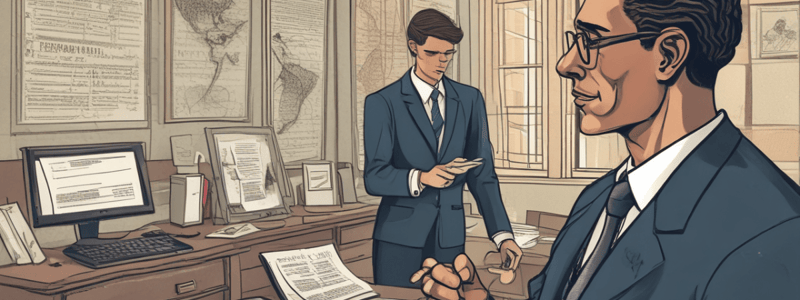Podcast
Questions and Answers
What happens to a violation classification if an investigation fails to substantiate a violation of law or policy?
What happens to a violation classification if an investigation fails to substantiate a violation of law or policy?
- It is escalated to a higher authority
- It remains classified as a violation
- It is dismissed and removed from the employee's history
- It is reclassified as unfounded, not sustained, or exonerated (correct)
When are employees notified of complaints lodged against them?
When are employees notified of complaints lodged against them?
- Only if the complaint is classified as a Category I infraction
- Unless notification would compromise the investigative process or any law enforcement or internal investigation (correct)
- Always, regardless of the investigation's progress
- Once the investigation is complete and a finding has been made
What is attached to the written notification of a complaint if it is considered a Category I infraction?
What is attached to the written notification of a complaint if it is considered a Category I infraction?
- A disciplinary action plan
- A warning letter
- A letter of reprimand
- Information regarding an 'Admit It and Move On' option (correct)
Who can request, in writing, that Internal Affairs consider approving an investigation for an 'Admit It and Move On' option?
Who can request, in writing, that Internal Affairs consider approving an investigation for an 'Admit It and Move On' option?
What types of investigations may be available to the employee throughout the process?
What types of investigations may be available to the employee throughout the process?
What is the next step if an 'Admit It and Move On' option originates from an Internal Affairs assigned case?
What is the next step if an 'Admit It and Move On' option originates from an Internal Affairs assigned case?
What is the purpose of the 'Admit It and Move On' option?
What is the purpose of the 'Admit It and Move On' option?
What type of infractions may be delegated to the employee's command for follow-up?
What type of infractions may be delegated to the employee's command for follow-up?
Until what stage can the 'Admit It and Move On' option be available to the employee?
Until what stage can the 'Admit It and Move On' option be available to the employee?
Who has the final determination in case of a conflict during an investigation?
Who has the final determination in case of a conflict during an investigation?
What is the first step in investigating an anonymous allegation of misconduct?
What is the first step in investigating an anonymous allegation of misconduct?
What happens if an investigation shows evidence substantiating any portion of an anonymous allegation?
What happens if an investigation shows evidence substantiating any portion of an anonymous allegation?
What is the classification of an investigation if it is received through an anonymous letter, fax, or correspondence?
What is the classification of an investigation if it is received through an anonymous letter, fax, or correspondence?
What is the purpose of documenting the source of the complaint as 'Anonymous'?
What is the purpose of documenting the source of the complaint as 'Anonymous'?
Which of the following is not a format for receiving an anonymous allegation?
Which of the following is not a format for receiving an anonymous allegation?
What is the primary responsibility of Internal Affairs in handling employee misconduct investigations?
What is the primary responsibility of Internal Affairs in handling employee misconduct investigations?
What is the supervisor's role in handling a complaint?
What is the supervisor's role in handling a complaint?
When can a complaint be handled verbally or in writing by a supervisor?
When can a complaint be handled verbally or in writing by a supervisor?
What should the supervisor do if they believe further action is warranted?
What should the supervisor do if they believe further action is warranted?
What precedes all investigations into employee misconduct?
What precedes all investigations into employee misconduct?
What should be attached to the request for an Internal Affairs Administrative Investigation?
What should be attached to the request for an Internal Affairs Administrative Investigation?
When should supervisors communicate with the Internal Affairs Division?
When should supervisors communicate with the Internal Affairs Division?
What is the purpose of a Citizen Contact in BlueTeam?
What is the purpose of a Citizen Contact in BlueTeam?
Who can complete a request for an Internal Affairs Administrative Investigation?
Who can complete a request for an Internal Affairs Administrative Investigation?
Who will receive written notification of the completed investigation?
Who will receive written notification of the completed investigation?
What is required of the person preparing an investigative report or summary?
What is required of the person preparing an investigative report or summary?
When can information about the investigation be disclosed?
When can information about the investigation be disclosed?
What is the role of investigators in determining the facts of a complaint?
What is the role of investigators in determining the facts of a complaint?
Who is responsible for preparing an investigative report or summary?
Who is responsible for preparing an investigative report or summary?
What is applicable only to deputy sheriffs and detention deputies?
What is applicable only to deputy sheriffs and detention deputies?
How can a complainant choose to submit their complaint?
How can a complainant choose to submit their complaint?
What should a supervisor do if they suspect a complainant is impaired?
What should a supervisor do if they suspect a complainant is impaired?
What is the purpose of the BSO Employee Recognition/Complaint Form?
What is the purpose of the BSO Employee Recognition/Complaint Form?
What might a complaint initially begin as, but actually be?
What might a complaint initially begin as, but actually be?
Who completes the relevant forms associated with the complaint process?
Who completes the relevant forms associated with the complaint process?
What is available in all public access areas of BSO facilities?
What is available in all public access areas of BSO facilities?
What is the role of a shift supervisor in the complaint submission process?
What is the role of a shift supervisor in the complaint submission process?
What is the benefit of having a supervisor or Internal Affairs investigator complete the complaint forms?
What is the benefit of having a supervisor or Internal Affairs investigator complete the complaint forms?
What happens to a complaint if the preliminary investigation determines no violation of policy and/or law?
What happens to a complaint if the preliminary investigation determines no violation of policy and/or law?
What type of allegations fall under Category I infractions?
What type of allegations fall under Category I infractions?
How may complaints be received?
How may complaints be received?
What happens to Category II infractions?
What happens to Category II infractions?
What is a complaint defined as?
What is a complaint defined as?
Who reviews complaints and determines the appropriate course of action?
Who reviews complaints and determines the appropriate course of action?
What is the purpose of tracking complaints by Internal Affairs?
What is the purpose of tracking complaints by Internal Affairs?
What type of infractions have the potential to result in a Disciplinary Suspension of six days or greater?
What type of infractions have the potential to result in a Disciplinary Suspension of six days or greater?
Study Notes
Investigation Classification and Notification
- If an investigation fails to substantiate a violation of law or policy, the classification will be reclassified as unfounded, not sustained, or exonerated.
- This classification will be denoted on the employee's history.
- Employees will be given notification if complaints are lodged against them, unless notification would compromise the investigative process or any law enforcement or internal investigation.
Admit It and Move On Option
- If the complaint is considered a Category I infraction, the Captain of Internal Affairs will review the employee's IA history.
- Information regarding an "Admit It and Move On" option will be attached to the written notification of the complaint.
- The district command may request, in writing, that Internal Affairs consider approving an investigation for an Admit it and Move On option.
- The Admit It and Move On option is available to the employee throughout the process, up to the pre-disciplinary hearing.
Investigation Process
- If the "Admit It and Move On" option originates from an Internal Affairs assigned case, the following steps will be followed:
- The case will be referred to the Captain of Internal Affairs for review.
- Category II infractions will be handled by Internal Affairs and Category I infractions may be delegated to the employee's command for follow-up.
- If a conflict arises, Internal Affairs and commands will consult, but the final determination is vested with the Captain of Internal Affairs.
Anonymous Allegations
- Investigations into alleged employee violations of law, policy, or procedures by an anonymous source will be classified as anonymous allegations.
- Investigations will be classified as anonymous allegations if received by:
- Anonymous letter, fax, or correspondence.
- Anonymous telephone call to a BSO facility or employee.
- Other format where the complaint initiator is anonymous.
- A Citizen Contact will be initiated by IA if an anonymous allegation of misconduct is received.
- The source of the complaint will be documented as "Anonymous".
- If an investigation shows evidence substantiating any portion of an allegation, the investigation will be updated to reflect the appropriate charge(s).
Supervisor's Role
- If a complaint can be handled verbally or in writing by a supervisor in a command, after appropriate review is conducted into the employee's previous disciplinary record (if any), the supervisor should do so.
- If the supervisor believes further action is warranted, then the supervisor will complete a Citizen Contact in BlueTeam.
- When there is doubt, supervisors (and commands) will communicate with the Internal Affairs Division to work out a course of action.
Complaint Handling Procedure
- Complaints can be received via telephone or in-person with a supervisor (preferably a sergeant or lieutenant) nearest to the complainant, with the option to give the complaint over the phone or meet with a supervisor.
Initial Complaint Review
- A complainant requesting to speak to a supervisor will be interviewed as soon as practical.
- The BSO Employee Recognition/Complaint Form will be available and displayed in all public access areas of BSO facilities.
- A supervisor will note if there is evidence of impairment by the complainant (mental, emotional, drugs, alcohol, etc.) and why the supervisor suspects the impairment.
Complaint Investigation
- No participant, including complainants, subject employees, investigators, and witnesses, will disclose any information about the investigation until it is closed and is public record.
- Investigators will use all available investigative resources to impartially determine the facts.
- At the conclusion of all complaint investigations, the complainant and employee will receive written notification of the completed investigation.
Investigative Report
- Agency personnel assigned to investigate the complaint will prepare an investigative report or summary, verifying that the contents are true and accurate based on personal knowledge, information, and belief.
Categories of Infractions
- Category I infractions: violations with potential discipline of five days or less, or a written reprimand, may be delegated to the employee's command for investigation.
- Category II infractions: violations of criminal offenses or discipline with potential discipline of six days or greater, loss/forfeiture of pay and benefits, demotion, and termination, will be investigated by Internal Affairs.
Complaint Reception Procedure
- A complaint is defined as an allegation of misconduct by an employee, involving a violation of policy and procedure, code of ethics, state or federal law, or other recognized standard of conduct.
- Complaints may be received by any means and need not be in writing.
- Complaints may be taken in person or anonymously, and will be reviewed by Internal Affairs and/or the employee's command.
Studying That Suits You
Use AI to generate personalized quizzes and flashcards to suit your learning preferences.
Related Documents
Description
This quiz covers the classification and notification processes of investigations, including reclassification of unsubstantiated violations and employee notification. Learn about the procedures and rules surrounding investigations.




